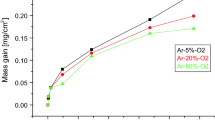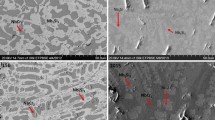Abstract
The Nb–15Re–15Si–20Cr–15Ti alloy was subjected to 24 h of air exposure in a temperature range from 700 to 1,400 °C. The Re addition to the Nb–Si–Cr–Ti alloy has been found to control pesting at lower temperatures, and spalling at higher temperatures. Formation of Cr2Re3 phase is believed to help in the lowering the oxidation kinetics, thus reducing pesting and spalling. Addition of titanium improves the oxidation resistance by forming intermetallics such as (Nb,Ti)5Si3, NbCr2, and Cr2Re3. The weight gain/loss per unit area as a function of temperature is used to determine the oxidation resistance. Oxidation characterization was carried out using XRD and backscattered imaging, EDS, and x-ray mapping modes on the SEM.












Similar content being viewed by others
References
J.H. Schneibel, Beyond nickel-base superalloys (Metals and Ceramic Division, Oak Ridge National Laboratory, Oak Ridge, 2005)
B.P. Bewlay, H.A. Lipsitt, M.R. Jackson, W.J. Reeder, J.A. Sutliff, Solidification processing of high temperature intermetallic eutectic-based alloys. Mater. Sci. Eng. A 192/193, 534–543 (1995)
K.S. Chan, Cyclic oxidation response of the multiphase niobium-based alloys. Metall. Mater. Trans. A 35A, 589 (2004)
C. Liu, P. Tortorelli, J. Horton, C. Carmichael, Effects of alloy additions on the microstructure and properties of Cr–Cr2Nb alloys. Mater. Sci. Eng. A 214, 23–32 (1996)
J.C. Carlen, Elyria, Ohio “Molybdenum–Rhenium Alloy” United States patent, Patent No. 5437744, 1 Aug 1995
K.S. Chan, Cyclic-oxidation resistance of niobium-base in situ composites: modeling and experimentation. Oxid. Met. 61, 165–194 (2004)
S.K. Varma, R.M. Dasary, Short term oxidation of Nb–15Re–15Si–10Cr–20Mo. J. Mater. Res. Technol. 3(1), 25–34 (2014)
J. Geng, P. Tsakiropoulos, A study of the microstructures and oxidation resistance of Nb–Si–Cr–Al–Mo in situ composites alloyed with Ti, Hf and Sn. Intermetallics 15, 382–395 (2007)
B. Bewlay, M. Jackson, H. Lipsitt, The balance of mechanical and environmental properties of a multi-element niobium–niobium silicide-based in situ composite. Metall. Trans. A 27A, 3801–3808 (1996)
K.S. Chan, Cyclic oxidation response of multiphase niobium-based alloys. Metall. Trans. 35, 589–597 (2004)
S.K. Varma, C. Parga, K. Amato, J. Hernandez, Microstructures and high temperature oxidation resistance of alloys from Nb–Cr–Si system. J. Mater. Sci. 45(14), 3931–3937 (2010)
Author information
Authors and Affiliations
Corresponding author
Rights and permissions
About this article
Cite this article
Dasary-Sierra, R.M., Varma, S.K. Short-Term Oxidation Response of Nb–15Re–15Si–20Cr–15Ti Alloy. Metallogr. Microstruct. Anal. 3, 224–232 (2014). https://doi.org/10.1007/s13632-014-0139-3
Received:
Revised:
Accepted:
Published:
Issue Date:
DOI: https://doi.org/10.1007/s13632-014-0139-3




